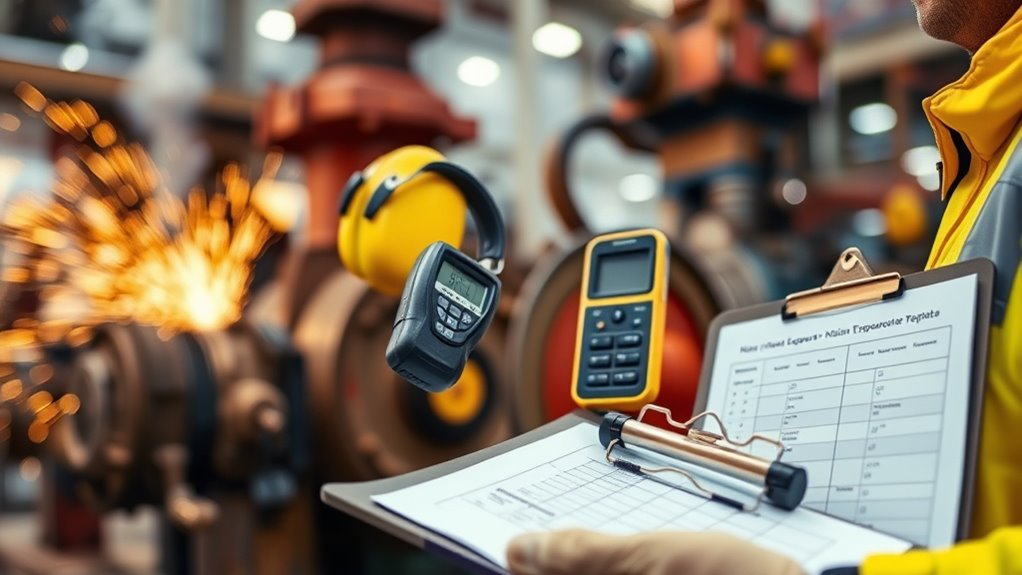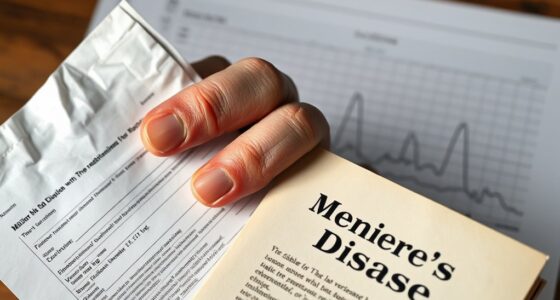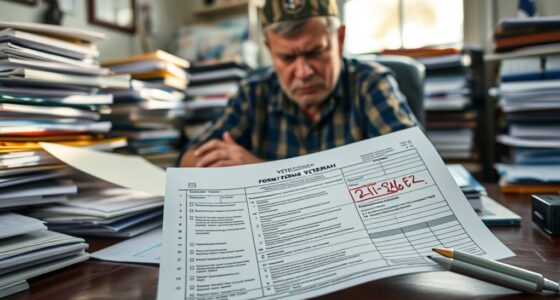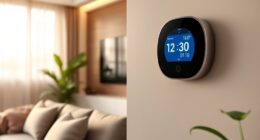To effectively document in-service noise exposure, use consistent templates that record date, activity, noise levels, duration, and protection used. Conduct regular noise assessments with tools like sound level meters or smartphone apps, and note patterns or peak times for exposure. Tracking this information helps you identify risks and adjust protective measures promptly. Maintaining organized records guarantees compliance and supports ongoing hearing health efforts—keep exploring for more tips to refine your documentation process.
Key Takeaways
- Use standardized templates to record date, duration, noise levels, activity, and protective equipment consistently.
- Conduct regular noise assessments with sound level meters or apps during work shifts or activities.
- Document peak noise exposures and identify patterns to inform targeted protective measures.
- Review and analyze exposure records periodically to identify trends and adjust safety protocols accordingly.
- Maintain organized, detailed logs to support compliance and facilitate timely interventions for noise-related risks.

Understanding and documenting your noise exposure is essential for protecting your hearing health. When it comes to managing occupational or recreational noise risks, conducting thorough noise level assessments is the first step. These assessments help you identify when noise levels reach or exceed safe limits, giving you concrete data to work with. By accurately measuring sound levels throughout your workday or activities, you can better understand your exposure and take appropriate steps to minimize harm. Exposure tracking methods are crucial here, as they allow you to record and analyze your noise encounters over time. Using tools such as dosimeters, sound level meters, or smartphone apps, you can gather real-time data that paints a clear picture of your noise environment.
Once you have collected this data, it’s vital to keep detailed records of your noise exposure. This documentation helps you identify patterns—whether certain tasks or times of day tend to be noisier—and enables you to implement targeted protective measures. For example, if your noise level assessments show frequent exposure to loud environments, you can plan to use hearing protection consistently or limit your time in those areas. Exposure tracking methods also facilitate compliance with workplace safety regulations, making it easier to demonstrate that you’re taking appropriate precautions. Incorporating Gold IRA strategies into your financial planning can also serve as a means to diversify your assets and hedge against economic fluctuations.
Keeping detailed noise exposure records helps identify patterns and ensure compliance with safety standards.
To streamline this process, consider using templates designed specifically for documenting noise exposure. These templates often include sections for recording date, duration, noise level readings, type of activity, and protective measures used. Filling out such templates consistently ensures you don’t overlook key details and makes it easier to review your exposure history. When you know exactly how much noise you’re exposed to and when, you can make informed decisions about your hearing health. This proactive approach can prevent noise-induced hearing loss and other related issues.
In addition, integrating noise level assessments into your daily routine helps create a habit of awareness. Regularly updating your exposure records and reviewing them can highlight trends and prompt timely interventions. Whether you’re working in a noisy factory or enjoying loud recreational activities, keeping track allows you to evaluate whether your current protective measures are sufficient or if adjustments are necessary. Remember, the goal is to maintain a safe hearing environment, and diligent documentation using exposure tracking methods and proper templates empowers you to do just that.
Frequently Asked Questions
How Often Should Noise Exposure Documentation Be Updated?
You should update noise exposure documentation regularly, ideally following your maintenance schedules and after any significant changes in equipment or work practices. Keep records current by reviewing and updating at least annually, and whenever employee training occurs or new noise hazards are identified. Consistent updates guarantee accurate tracking, help maintain compliance, and protect employee hearing health. Staying proactive with documentation also supports effective noise management and safety protocols.
What Legal Requirements Exist for Documenting Noise Exposure?
While noise measurement guides your actions, legal compliance mandates proper documentation. You must record noise exposure levels accurately, keep detailed records, and adhere to OSHA or relevant regulations. These legal requirements guarantee your workplace remains safe and compliant, avoiding penalties. By consistently documenting noise exposure, you demonstrate due diligence, protect employee health, and satisfy legal standards, making it an essential part of your safety protocols.
Which Tools Are Best for Recording Noise Levels Accurately?
You should use sound level measurement tools like a calibrated sound level meter or a dosimeter to record noise levels accurately. These tools provide precise measurements of sound levels in decibels, helping you monitor in-service noise exposure effectively. Make certain to select equipment suitable for the environment and follow manufacturer instructions for calibration. Consistent use of reliable measurement tools ensures you document noise exposure properly and comply with safety standards.
How Do I Handle Confidentiality in Noise Exposure Records?
You handle confidentiality in noise exposure records like a superhero guarding a secret vault. Follow strict confidentiality protocols, limiting record access to only those who absolutely need it—no exceptions. Use secure storage methods, like encrypted digital files or locked cabinets, and regularly review your access permissions. By doing this, you guarantee sensitive information stays safe, preventing any unauthorized ears from hearing the confidential details and keeping your workplace trustworthy and compliant.
Can Digital Templates Be Customized for Different Industries?
Yes, digital templates can be tailored for different industries. You can easily leverage digital customization to create industry-specific templates that suit your unique noise exposure documentation needs. This flexibility allows you to tailor fields, layouts, and details based on industry standards or regulations. By customizing templates digitally, you guarantee accurate, consistent records while saving time, making your noise exposure documentation more efficient and relevant to your sector.
Conclusion
By consistently documenting your noise exposure, you protect your hearing and guarantee compliance. For example, imagine a factory worker who notices ringing in their ears; having detailed records helped them seek proper intervention sooner. Keeping clear, accurate records isn’t just paperwork—it’s your safeguard against long-term hearing damage. Make it a habit today, so you’re prepared tomorrow. Proper documentation empowers you to take control and prioritize your hearing health effectively.











